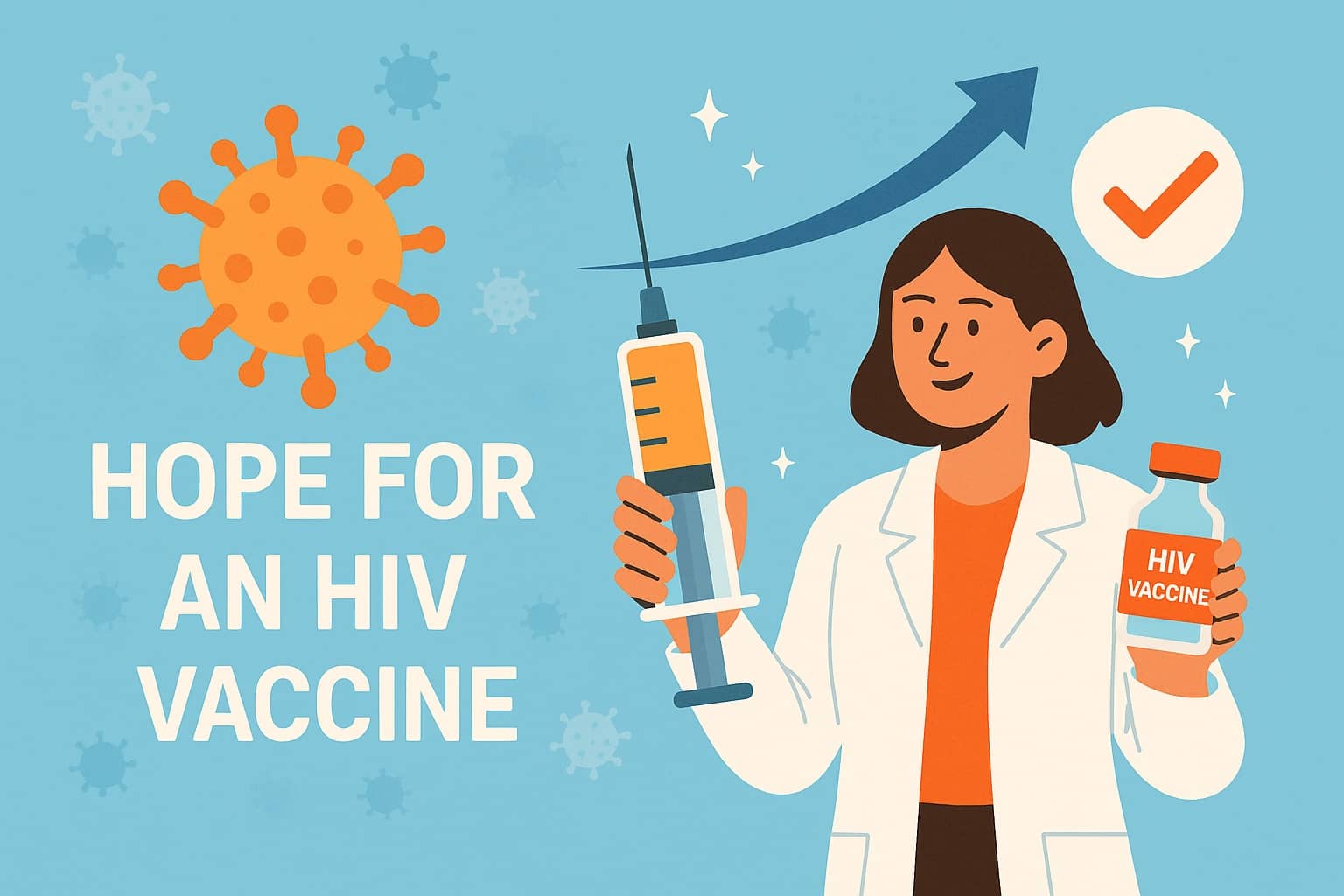For decades, HIV has resisted every attempt at a vaccine. Unlike viruses such as measles or polio, HIV changes constantly. It hides its most vulnerable parts, making it difficult for the immune system to target. Traditional vaccines haven’t worked, not because scientists lacked effort, but because HIV is uniquely evasive.
Now, researchers may have found a way forward. Two early-stage clinical trials, led by IAVI and Scripps Research, have shown that it’s possible to spark a specific immune response in humans. This response could eventually lead to broadly neutralizing antibodies – immune cells capable of recognizing and disabling many strains of HIV.
The studies, conducted in North America and Africa, used a sequence of specially designed shots: a priming vaccine followed by a targeted booster. The approach worked consistently across both continents. Results were published in Science in May 2025, marking a breakthrough that scientists have spent years working toward.
According to Dr. William Schief of Scripps Research, “We’ve shown that one shot can start the right immune response, and another can push it further. We’ve also seen it work well in African volunteers, which is essential for a vaccine meant for global use.”
This matters. Every HIV vaccine that’s reached large trials in the past has failed to protect people. But this new approach proves a concept long considered out of reach – that the immune system can be guided, step by step, to produce the rare antibodies needed to fight HIV. While it’s not yet a finished product, it’s a strong sign that we’re finally heading in the right direction.
What Are Broadly Neutralizing Antibodies, and Why Do They Matter?
Most vaccines teach your immune system how to spot a virus and shut it down. They do this by helping your body make antibodies which proteins that latch onto viruses and block them from causing infection. The problem with HIV is that it mutates constantly. What works against one version might miss the next.
That’s where broadly neutralizing antibodies, or bnAbs, come in. These are rare types of antibodies that can recognize the parts of HIV that don’t change, no matter how many tricks the virus pulls. They aim for the virus’s weak spots, the parts it can’t afford to alter, and stop it from spreading.
A small number of people living with HIV naturally develop bnAbs, usually after years of infection. Scientists have isolated these antibodies and tested them in labs and early trials. In some cases, giving people bnAbs directly helped block HIV infection, showing they might work as a preventive tool.
The real challenge is getting a vaccine to spark that same bnAb response. The immune system tends to go for easier, more obvious targets on the virus. But those targets change fast. bnAbs need a different approach. The immune system has to be shown how to focus on HIV’s more stable, hidden features.
The new vaccine strategy doesn’t try to do it all at once. Instead, it starts by waking up the rare immune cells that have the potential to make bnAbs. Later shots guide those cells to grow and adapt until they produce the right kind of antibodies. Think of it like teaching your immune system a long game. And for the first time in human trials, this approach is actually working.
Breakthrough Trials Prove the Strategy Works
The new vaccine concept was tested in two early-stage trials: one in the United States (called IAVI G002) and another in Africa (IAVI G003). Both trials focused on the same goal, to see if the vaccine could kickstart the rare immune cells needed to eventually produce bnAbs.
IAVI G002 (North America)
This trial involved 60 volunteers in the U.S. Participants received either one or two doses of a priming vaccine, followed by a booster shot designed to push their immune response further. The vaccines used mRNA technology, the same platform used in COVID-19 vaccines, which helps the body make the HIV-related proteins that train the immune system.
The results were impressive. Everyone who received both the prime and the booster developed what scientists call VRC01-class antibodies. These are early versions of the bnAbs researchers are aiming for. Over 80% of those people had especially strong responses, with immune cells that showed signs of maturing in the right direction.
Even participants who only got the priming shots showed encouraging responses, although those antibodies were less developed. Interestingly, one priming dose followed by a booster worked better than giving two priming doses before boosting. That insight is already helping researchers fine-tune the next stages of vaccine design.
IAVI G003 (Africa)
The second trial took place in Rwanda and South Africa. It focused on testing whether the priming vaccine alone could activate the right immune cells in African populations, which is key, since the global burden of HIV is highest in these regions.
Participants received two doses of the priming shot. After vaccination, 94% showed the desired immune response. That means the vaccine successfully activated the rare cells needed to eventually build up bnAbs. And the quality of those responses was just as strong and diverse as those seen in the U.S. trial.
Only one participant didn’t respond, and further analysis revealed they carried a gene variant that likely affected the result. For everyone else, the vaccine did exactly what it was supposed to. This is a crucial win, especially since a future vaccine will need to work across diverse populations worldwide.
Why This Matters: Global Impact and Expert Reactions
This breakthrough doesn’t just move the science forward. It changes the mood in the HIV research world. For years, trial after trial came up short. Large-scale vaccine efforts in places like South Africa and Latin America failed to protect participants from infection. That reality had many experts questioning whether an HIV vaccine was even possible.
Now, researchers have proof that the immune system can be guided to respond in the right way. The concept of a stepwise vaccine design is no longer just theory as it works. And the consistency between North American and African participants suggests the strategy could be used globally.
According to Dr. Constance Schultsz, professor of global health at Amsterdam UMC, the results represent “an important step” achieved through years of global collaboration. She also pointed out the need to sustain momentum, especially in an environment where public health research often faces slowdowns due to funding cuts or shifting priorities.
It’s still early. This vaccine doesn’t prevent HIV yet. But it shows that a vaccine can activate the right immune cells and steer them toward producing bnAbs. This opens the door to future trials that could add more booster steps, mature those cells, and potentially block HIV before it gains a foothold.
Dr. Mark Feinberg, president and CEO of IAVI, summed it up: “A vaccine would be a tremendous step forward for global health. It could help bring an end to the HIV pandemic.”
These trials also highlight the power of collaboration. Scientists, funders, volunteers, and communities from multiple countries came together to make this happen. It shows what’s possible when research moves beyond borders. A model that future trials will likely need to follow.
HIV Prevention Today: Using Every Tool We Have
While vaccine research moves forward, HIV can already be prevented with tools we have today. Around the world, including in places like Singapore, prevention efforts have helped reduce new infections. But these tools only work if people know about them and feel safe accessing them.
Testing
The first step is knowing your status. HIV testing is fast, accessible, and often anonymous. In Singapore, self-test kits are available at pharmacies, and clinics like Shim Clinic offer discreet testing options. Regular screening is recommended, especially if you’ve had new partners or possible exposure.
PrEP
Pre-exposure prophylaxis (PrEP) is a daily or on-demand medication that protects HIV-negative individuals. When taken consistently, PrEP can reduce the risk of sexual transmission by up to 99%. In Singapore, it’s available by prescription through qualified doctors and clinics. It’s safe, effective, and a growing part of prevention strategies worldwide.
PEP
Post-exposure prophylaxis (PEP) is for emergencies. It’s a 28-day course of medication that needs to start within 72 hours of possible exposure. The sooner you start, the more effective it is. If you’ve had unprotected sex or suspect an exposure, don’t wait. Clinics and hospital emergency rooms can assess and start PEP quickly.
Condoms and Safe Sex
Condoms remain one of the simplest and most effective ways to prevent HIV and other STIs. Use them consistently and correctly. They’re widely available, affordable, and still matter even with PrEP or PEP. Safe sex also includes open communication, getting tested together with partners, and understanding your protection options.
Treatment as Prevention (U=U)
Modern HIV treatment can reduce the virus to undetectable levels. This is the basis of the U=U principle: Undetectable equals Untransmittable. People living with HIV who maintain an undetectable viral load do not pass the virus to their partners. In Singapore, treatment is accessible and effective. Early diagnosis and adherence to medication are key.
These tools work best when combined. Regular testing, prevention meds, condoms, and early treatment all reduce the spread of HIV. A vaccine might be on the horizon, but prevention already works. Knowing your options and using them is how we stop the virus now.

